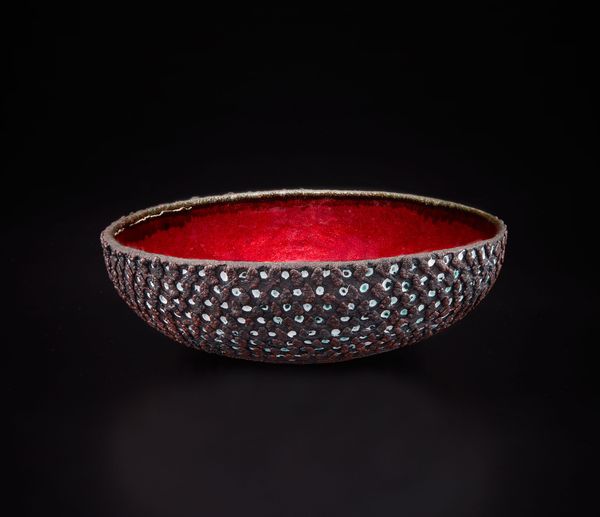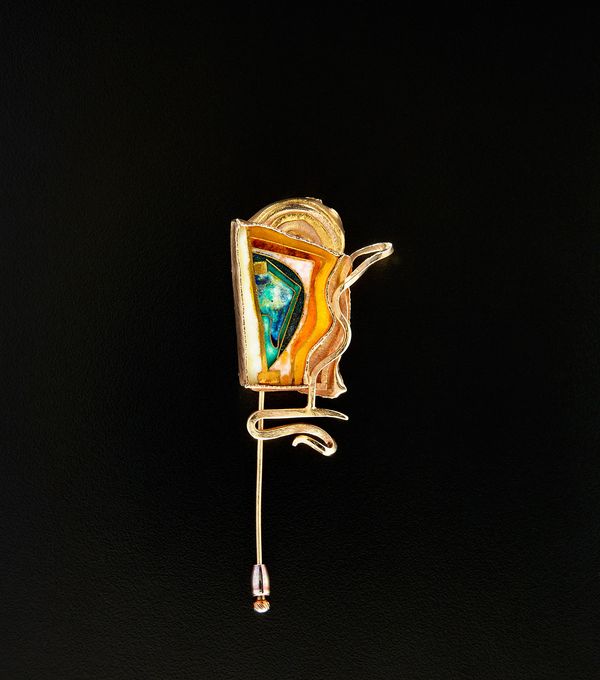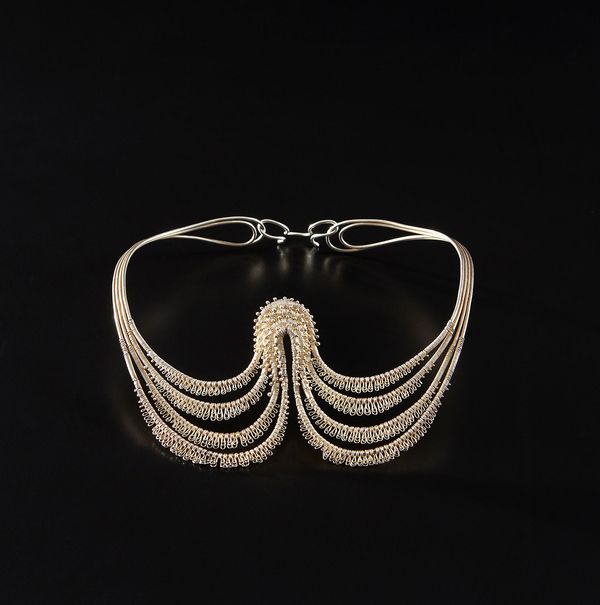June Schwarcz Bowl #592, 1971. Hammered copper with enamel, patina, and electroplated texture. From the Collection of William Harper.
The tradition of hand-making objects has endured every industrial revolution and technological innovation and emerged all the better for it, with each new generation of maker armed with new material explorations and challenges to push traditional crafts into a contemporary context. In the 1960s and 1970s, the small corner of the design community that enamel occupied was undergoing a renaissance driven by two major figures who were trailblazing ahead with a new approach to an old art.
Enamel is an ancient method of fusing crushed and ground glass into a smooth liquid that is applied to a metal surface in a decorative pattern, and it has been used by nearly every civilization from ancient times to the present. It requires enormous skill, patience and rigorous attention to detail, and for artists of the mid-twenieth century, it presented an opportunity to stop using enamel as a medium to mimic painting, but to admire it for what it is, and let it be its own materiality, fully recognized for its own singular and unique properties. Two of the biggest forces in this movement are June Schwarcz and William Harper.
June Schwarcz studied design at the Pratt Institute in Brooklyn, New York and began working with enamel in 1954 after happening upon an enamel workshop at the Denver Art Museum. Just two years later, her work was included in the inaugural exhibition at the Museum of Contemporary Crafts (now the Museum of Arts and Design) in New York, which immediately earned her recognition. By 1962, Schwarcz had moved to Sausalito, California and was exhibiting her work extensively. She began using sophisticated electroplating and electroforming techniques for a more sculptural effect in her vessels and became a pioneer of experimentation in this field.
William Harper Brooch, "Ripe Blossom IV", 1992. Cloisonné enamel, gold, silver. From the Estate of June Schwarcz.
During this time, William Harper, an enamelist from Cleveland, Ohio was on his first trip to New York City in 1966, when he visited the Museum of Contemporary Crafts where he saw Schwarcz’s work "using enamel in a way that [he] had never seen before." Harper recalled in a 2004 interview for the Smithsonian’s Archives of American Art that "seeing her work enforced that kind of undiscipline…in myself."
By 1970, Harper had been experimenting with welding techniques to achieve the "rough elegance" of Schwarcz’s work, which fortuitously led him to his own explorations of cloisonné, the ancient technique of using a thin wire to create a design to hold the enameled surface of an object, but Harper took a more freeform and sculptural approach, and this would be the technique that would become so emblematic of his work. By the late 1970s, Harper had the rare honor of a solo exhibition at the Renwick Gallery of the Smithsonian Institution in Washington, DC and from that point on would be represented by some of the most prominent galleries of the movement including Helen Drutt, the Kennedy Galleries, Peter Joseph and Franklin Parrasch.
In 1998, on the occasion of a retrospective of June Schwarcz’s life work in the field of enamel at the San Francisco Craft and Folk Art Museum, William Harper was tapped to interview Schwarcz for the museum’s exhibition catalogue. In the long-standing tradition of artist relationships, the two artists traded works for each to have in their own personal collections. The June Schwarcz bowl was traded that day for the William Harper brooch. Reunited here in this auction, these works are the culmination of the careers of two artists who pushed America into the spotlight for their experimentation in the field of craft.
June Schwarcz was designated a Living Treasure of California in 1985 for her contributions in experimental enamel which would influence generations of future artists and designers. She was working well into her nineties until she passed away less than a year ago at the age of 97. In an interview in 2012 she said "You know, when you’re 93, people think you’re amazing just for getting out of bed in the morning. With a limited time to live, there’s a decision to make every day — what to spend it on, what to create."
June Schwarcz’s works are included in the permanent collections of the Museum of Arts and Design, New York; The Renwick Gallery of the Smithsonian Institution, Washington, DC; de Young Museum, San Francisco; Zurich Design Museum, Switzerland; The Metropolitan Museum of Art, New York and the Museum of Fine Arts, Boston, among others.
William Harper’s works are included in the permanent collections of The Metropolitan Museum of Art, New York; the Cooper-Hewitt, Smithsonian Design Museum, New York; Mint Museum of Art, Charlotte, North Carolina; Philadelphia Museum of Art, Pennsylvania; Victoria and Albert Museum, London; Yale University Art Gallery, New Haven, Connecticut; The Vatican Museum, Vatican City, and the Renwick Gallery of the Smithsonian Institution, Washington, DC among others.
Mary Lee Hu Neckpiece, 1970s. Sterling silver. From the Estate of June Schwarcz.
Mary Lee Hu studied metalwork and jewelry at Cranbrook Academy of Art in Bloomfield Hills, Michigan and earned a graduate degree in metalsmithing from Southern Illinois University, Carbondale in 1965. Her studies here also included a fiber arts course which led to the creation of her signature use of textile techniques in jewelry by weaving, wrapping and knitting silver or gold wire. Hu often found inspiration in Taiwanese and Tibetan art as well in natural forms including insects and animals. The neckpiece shown here is a fine early characteristic example of her work, from the personal collection of the renowned enamelist June Schwarcz.
Mary Lee Hu’s works are in the permanent collections of the Art Institute of Chicago, Illinois; Victoria and Albert Museum, London; the Museum of Arts and Design, New York; The Metropolitan Museum of Art, New York; The Museum of Fine Arts, Boston; The Museum of Fine Arts, Houston; the Renwick Gallery of the Smithsonian Institution, Washington, DC; Columbus Museum of Fine Arts, Ohio; and the Yale University Art Gallery, New Haven, Connecticut, among others.


